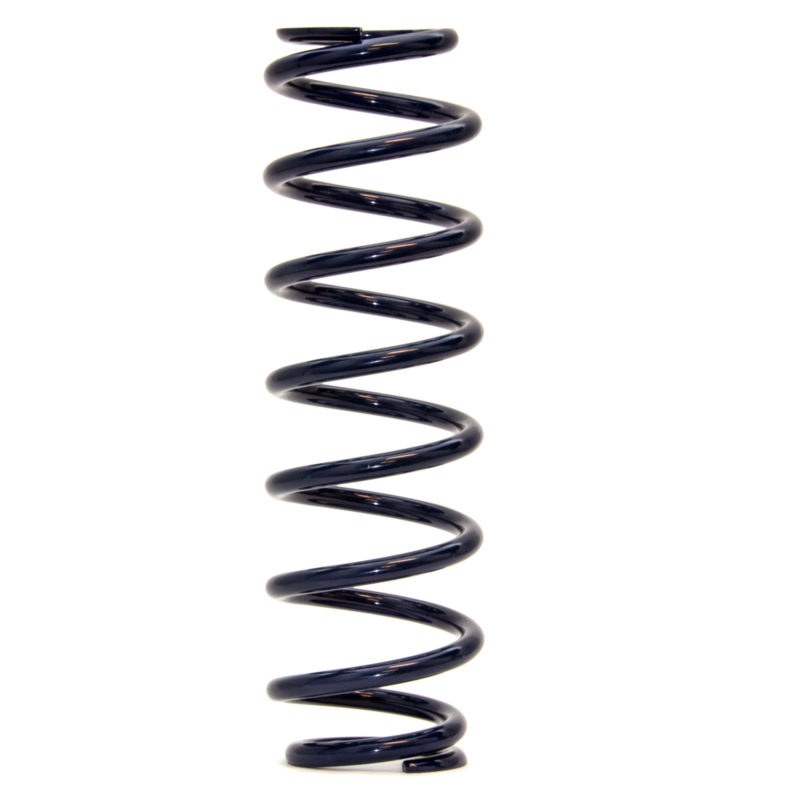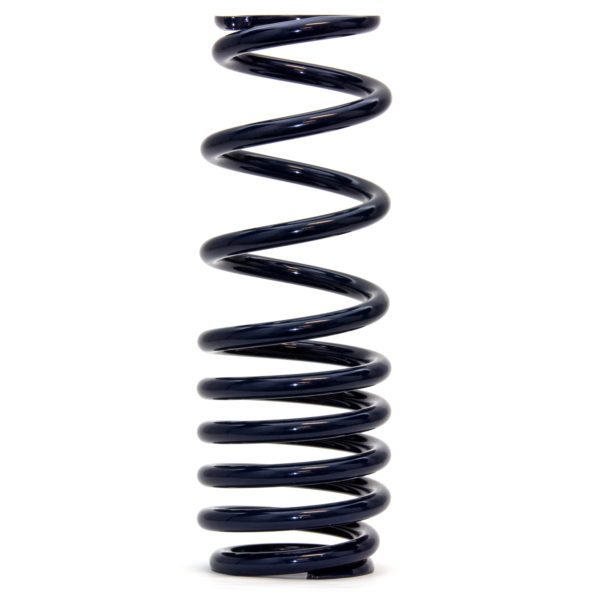Progressive Springs Vs. Linear
Compare and Contrast Linear and Progressive Rate Suspension Springs
Within the realm of motorsports and high-performance driving, there is considerable debate about whether “linear rate” or “progressive rate” suspension springs are better for a specific type of event or vehicle. As with anything that is an engineered product, there are always trade-offs. It is almost impossible to design a product that is all “pros” and no “cons.” Generally, we try to accentuate the positive characteristics while minimizing the negative characteristics. Let’s get started by defining the difference between these two types of springs.

“Linear rate springs” have one defined spring rate per inch of deflection throughout most of their range of deflection. For instance, if we have a 300lb/in linear rate spring that is 12 inches long, it will take approximately 300lb to deflect it 1 inch. The next inch of deflection will take another 300lb of load, and the next inch of deflection will take an additional 300# of load (and so on until the spring goes solid). At this point, there will be 900lb of load on a 12-inch long spring that has now been compressed to a 9” spring height.
The “linearity of rate” makes it quite easy to calculate a given spring length at ride height, and this helps in setting up the ride height of a specific vehicle. If we know that we have 750lbs of sprung mass on a corner and we want to run a 250lb/in linear rate spring, we know the spring will compress 3 inches (750lbs ÷250lb/in = 3 inches). That helps us anticipate the total travel of the spring. Also, by measuring the total travel of the damper, we can easily estimate the total load placed on the spring during an event.
“Progressive rate springs” are generally classified into two sub-types: 1) constantly increasing rate springs and 2) a “dual-rate” spring with two linear rates connected with a rate-transition range.
The first type (constantly increasing rate) of springs is most often used as “load-compensating springs” on the rear of a vehicle when the vehicle will often see significant load changes in the cargo area. These are most often stock replacement type suspension springs. They are identified most easily by the continually varied spacing between the coils. One area of racing where constantly increasing rate springs are used is dirt modified racing, where pull-bar springs, using a constantly increasing spring rate, are used to control rear axle wrap during acceleration. These springs are not suspension main springs but are supplemental springs.

The second type of progressive rate suspension spring, the dual-rate spring with two linear rates connected with a rate transition range, is a much more sophisticated suspension spring. The design is much more focused on the specific use for the spring. These types of springs are used primarily in road racing and high-performance street and GT applications where the vehicle trim package will stay in a very predictable range. These springs are easily identified by having a few closely wound coils at one end and then wider, equal-spaced coils at the other end. They have rates described as 200/425lb/in. This means that the spring has an initial rate of 225lb/in through some range of deflection, and then the rate transitions to 425lb/in through a deflection range of 1”-1.5.” The big advantage of these springs is that they can provide “roll control” in addition to roll control provided by sway bars.
Let’s discuss roll control provided by springs. For “linear rate springs,” the discussion is easy. They provide no roll control! Think about taking a curve at a very high speed. The side of the car on the outside of the turn rolls over, and the side of the car on the inside tends to roll up. For discussion's sake, let’s assume we have 300lb/in linear rate springs on the front of our car and the car is rolling too much, and cornering speed suffers. If we move up to a set of 400lb/in springs in an attempt to “stiffen” the suspension, we fail because the linear rate springs provide no roll control. Think about it. As you enter the same curve at the same speed, your vehicle is rolling onto a higher rate spring, BUT the inside of the vehicle is being pushed up by a higher rate spring, also. So there is no improvement with roll control. With linear rate springs, all roll control must come from the sway bar (anti-roll bar).
With properly designed progressive rate springs, we can have the springs contribute to the roll control of the vehicle. The key here is to have the vehicle sit in the rate transition range at curb ride height with the designed number of passengers in the vehicle. For racing applications, this is usually one person of a known weight. For GT and high-performance driving, this is usually two people of approximately 180lb each and a full tank of fuel.
When the vehicle sits at the rate transition point, the closely wound coils will be closed almost to the solid point. This often necessitates the use of rubber or synthetic coil covering on one or more of the closely wound coils to minimize noise when the coils go solid. Let’s assume we are working with a 200/425lb/in spring. At ride height, we will be sitting on the low end of the rate transition range, about 210lb/in. As we enter a high-speed turn, the outside of the vehicle will roll into the 425lb/in spring rate, and the inside of the vehicle will be pushed up with a much lighter 200lb/in rate. This provides a significant improvement in roll control. The use of a sway bar will supplement roll control and can provide a more focused level of suspension tuning.
This all sounds very good, and one could easily say, make all road car springs progressive rate springs; but it isn’t that easy. There are several considerations that must be kept in mind when designing progressive rate springs:
What is the amount of suspension travel necessary? Progressive rate springs generally have less total deflection compared to a linear rate spring of the same free length. This is because the closely wound coils needed to create the dual rates take up deflection space.
Because of the reduced total deflection, progressive rate springs should have a relatively long free length. Short springs and progressive rates do not mix well!
What load is needed at the transition point, and where in the deflection point should the transition range be placed? Progressive rate springs designed for GT or high-performance driving will work great with 1 or 2 people in the vehicle. However, if you put 4 people in the vehicle, load the trunk, and/or hitch up a trailer; you are guaranteed to have a ride height well beyond the rate transition range, and the vehicle will ride very harshly, and you will have lost the roll control element of the springs.
The range of rates is limited by where the transition range must be. This means that many rate/transition range schemes cannot be packaged in a vehicle just because it is desired.
So what is the best way of proceeding when it comes to selecting spring rates? For oval track racing, linear rate springs are the easiest to set up and get a chassis competitive. If progressive rates are desired, stacking two linear rate springs with some specialized hardware offers greater tuning possibilities with more convenience and less cost.
In road racing, progressive rate springs offer some potential; but the need for long free lengths adds weight and packaging considerations that often offset the advantages of a progressive rate spring.
For grand touring and high-performance driving, progressive rate springs offer great ride quality and superior handling due to the roll control offered by the springs. This is especially true if a reduced ride height is desired. The initial light rate provides a great ride, while the increased secondary rate assures a load-carrying capability unavailable if lowering with a linear rate spring is attempted. Most high-performance driving involves a fixed vehicle package with only one or two passengers and very limited extra weight. This is the ideal situation for progressive rate springs.
Contact Us
For more information on Hyperco products, capabilities, or resources, contact us.